What Is Interactive Content?
Interactive content encourages people to engage with the information being presented. Effective interactive content provides value and appeals to the target audience while gathering helpful information about visitors. Businesses can then use this information to tailor offerings that meet each person's specific preferences.
If you’re old enough to remember MySpace, you’re probably wearing glasses and going to bed at a reasonable hour.
You also likely remember all the fun quizzes you could do before the times when Cambridge Analytica sucked the joy out of it. You didn’t know it at the time, but that type of entertainment is known as interactive content.
It was the beginning stages of a new era in technology, and it completely changed the landscape of how we consume information. But, as with everything else relating to tech, this type of content has continued to evolve.
Web 2.0 provides the perfect opportunity for interactive content to have a renaissance. It’s particularly powerful in B2B marketing, since it cuts through the clutter and offers a unique experience. Many marketing materials offer only a one-way conversation. Interactive content is different.
What Is Interactive Content?
Interactive content is one that lets you engage with the information. It’s an efficient way to maximize marketing efforts, since, as you answer questions or click on options, you’re providing useful information that allows companies to tailor their offerings to your specific preferences and needs.
Many B2B companies have had remarkable success with interactive assessments that help a user understand their product options. In addition, this type of content:
- Provides value in a way that’s relevant and interesting
- Appeals to users’ emotions, curiosity, or vanity
- Offers insights tying back to data or current events
- Furnishes opportunities for users to focus on their interest
In a nutshell, traditional content is so 1982. Today, interactive content is where it’s at. But wait. Why is it so effective? And what are some cool examples that have propelled popular brands to extraordinary success? Glad you asked.
Why Is Interactive Content Marketing Effective?
There are many benefits to creating interactive content marketing — and they’re all tailored to making users fall in love with what you have to offer.
It Generates User Engagement.
Sharing useful content is an essential component of digital marketing. And, depending on your industry and a user’s stage in the sales funnel, maybe all they need to do is read what’s on the page, then take some time to digest it.
However, interactive content helps you strengthen your relationship with prospects. You ask them relevant questions, and they answer.
It Helps You Create a More Accurate Buyer Persona.
Buyer personas are semi-fictional representations of your ideal customer, based on data and educated guesses. While you may have a general idea of who your ideal customer is, by gathering additional information, you may identify factors you hadn’t considered before, such as what motivates them or whether they have any hesitations.
You Can Target Your Efforts On Quality Leads.
Your products or services may be the best invention since sliced bread, but let’s be honest — not everyone needs it.
Instead of wasting time with people who wouldn’t benefit from your goods or services, interactive content helps you narrow down your list of prospects, so that you can focus your efforts on them. It also gives you insights so that you can tailor your content depending on the current stage of their buyer’s journey they're in.
It Helps You Provide a Customized Experience.
Most people enjoy talking about themselves. Go ahead. Try it. Ask a friend or coworker to tell you about why they like [insert their favorite hobby here].
The same happens with website users. Interactive content lets users tell you about their likes, preferences, and pain points. You can then take this information to provide solutions that are relevant to them.
You Can Increase Brand Loyalty.
Since you’re customizing content based on data users have provided, they’ll end up with content that’s actually helpful specifically to them. You are focusing on solving their problems.
Being this customer-centric increases satisfaction and ensures that they keep coming back for more. They are also more likely to recommend you to friends and family — which is invaluable, considering that word of mouth is the most powerful form of marketing.
13 Examples of Interactive Content Types That Work
Quizzes, surveys, calculators, chatbots, and interactive charts, infographics, and maps are all great ways to engage prospects and customers; and there are plenty of examples of brands that have taken this strategy and elevated it to an art form.
1. My Disney Experience App
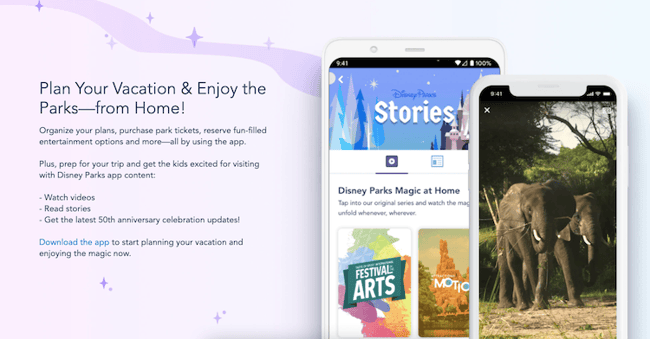
Once upon a time, you went to theme parks expecting to stand in line for hours. Thanks to the My Disney Experience app, you can book Fast Passes for some of the rides, and even check how long wait times are for the other ones.
You can also sync it with your Magic Band so that you can use it to connect your PhotoPass, order food, make payments, and even use it as a hotel key. You enter info, and the app ensures it makes your life easier throughout your entire stay at their resorts.
2. Live Nation
If you like live music, Live Nation’s got you covered. All you have to do is purchase concert tickets from their lineup, and the app will show you an interactive seat map, store your tickets digitally, and keep you updated on any news about your show (such as whether it has been postponed due to public health concerns like COVID-19 or whether the venue has new rules).
It also notifies you about upcoming events that you may like, based on the tickets you’ve previously purchased.
3. Starbucks Mobile App
Whether you like to drink black coffee or prefer to order a designer drink (tall double almond milk macchiato with an extra pump of flavoring, hold the whip), the Starbucks Mobile app lets users specify what they like and order online so that they don’t have to wait once they arrive at their local store.
It also suggests foods that pair well with your drink order and provides a rewards program — collect enough stars and get a free beverage. Users tell Starbucks what they like and the app ensures to keep them hooked.
4. Spotify
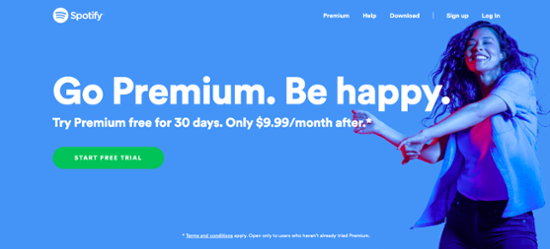
Gone are the days of browsing through record stores. Now, everything’s stored in a cloud. Spotify lets you create playlists, then suggests additional music based on the genres you listen to and even the activities you do while listening to them.
Name a list Running Playlist, and see your suggested offerings have names like All Out Running and Workout Beats. If you prefer to listen to radio stations, you can combine audio with talk content. It’s like it knows what you want before you even know.
5. Netflix
Following in the footsteps of Starbucks and Spotify, Netflix also creates viewing queues based on films and shows you enjoy watching.
But in addition to the traditional way of suggesting content, it also provides viewers with the choice to pick characters and shape stories. As a result, there’s a new storyline each time you watch the content. This first became a favorite with children but was later expanded to older audiences with Black Mirror: Bandersnatch and You vs. Wild.
6. PayPal
PayPal makes money transfers and making payments easy. It also lets users keep track of their investments through an interactive stock chart and allows vendors to customize their payment buttons and give buyers the options of paying with a debit or credit card, or by using Venmo (while still remaining on the PayPal platform).
7. ThirdLove
Ask anyone who’s ever needed to wear a bra whether shopping for the garment is among their favorite experiences, then wait for their reaction. ThirdLove comes to the rescue by taking away the guessing game.
Upon visiting the website, users are given the option to take the Find My Fit quiz, with simple questions designed to take the misery out of bra shopping. And as with most retailers in the digital age, it then suggests purchases based on your specific needs.
8. Zillow
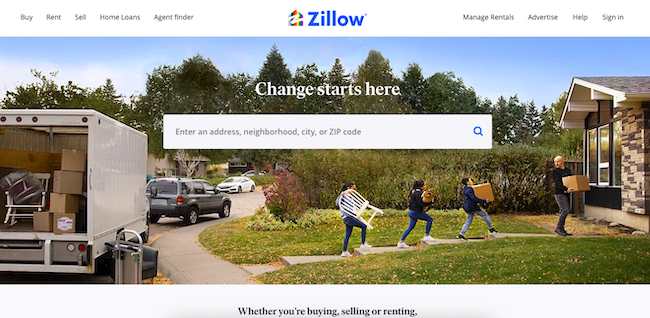
Zillow not only shows you houses that have recently been listed for sale. It also lets users specify their desired features in a home, has a mortgage calculator, and offers interactive floor plans and video tours.
And, based on all the information you enter, you can then receive marketing emails showing you homes in your area that meet your desired criteria.
9. Pew Research Center
Pew Research Center wants to know if you can tell the difference between fact and opinion in news articles. In a piece of interactive content truly ripped from headlines, it gives you a chance to evaluate 10 phrases and determine which ones are objective statements and which ones aren’t.
While the quiz itself is simple, the fact that it’s from Pew lends it gravitas. Plus, it centers around a timely global problem, making it uniquely topical.
10. The New York Times
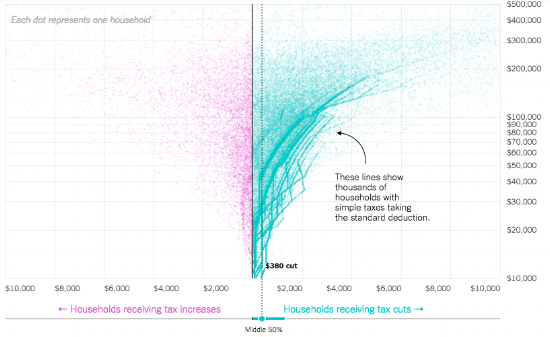
Like a fun infographic, interactive content often helps people make sense of complex topics that would be difficult to slog through in a more conventional, linear way. Your power to help your audience focus in on what interests them the most is limited only by your imagination.
The New York Times answers a burning question among its readers with its tax bill calculator, which allows users to better understand the concrete effect of the new tax rules on their income from the 2018 tax reform bill. Not only does it provide valuable insights, but the data is visualized beautifully, too.
11. Quartz at Work
Quartz at Work shines a light on the hours of unpaid labor performed by women with a custom calculator that links common household chores to market rates.
This provides a striking perspective on tasks that many women (and some men, of course!) do around the home without thinking about it and the opportunity costs they represent.
It’s a hot topic that could rub some the wrong way, but the interactive content by Quartz handles it in a straightforward manner with a quick and simple calculator that cuts to the heart of the issue.
12. PBS
How many books have you read lately? PBS, the go-to for smart television content, wants to know with its interactive assessment, “The Great American Read.” This provides a big list of 100 classic books, in order alphabetically, so big brains can compare their reading prowess.
Subtle differences in the format and presentation position the PBS quiz for appeal to its target audience while still maintaining the snappy and sleek presentation everyone expects from Web 2.0. That means it stands out and gets more currency among users who might not enjoy simpler quizzes.
13. FiveThirtyEight
FiveThirtyEight is truly one of the web’s leaders in incisive interactive content. It has the luxury of dissecting breaking news from all angles to craft a truly memorable experience out of it.
For example, How to Win a Trade War is an astonishing piece of interactive content that pits you against past players by simulating their patterns of behavior to show how international trade wars work.
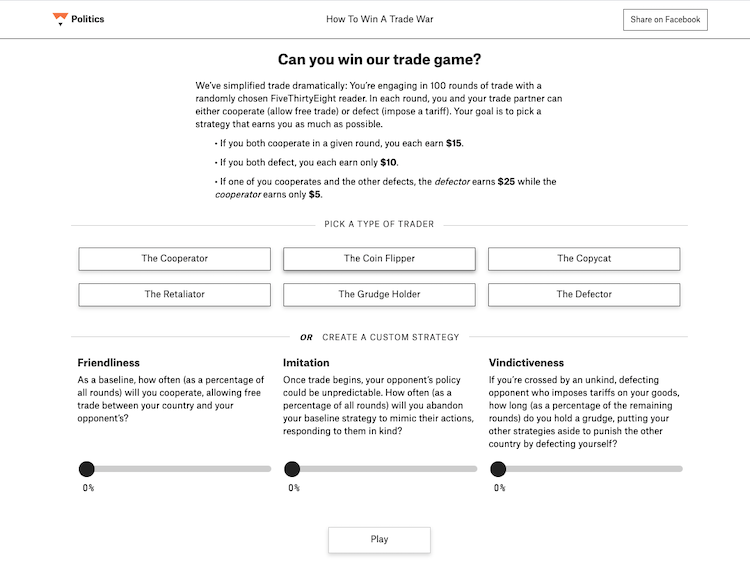
By choosing from one of six trade strategies (or developing your own with sliders), you live your own trade war scenario and see the odds of winning.
There are several interesting things about How to Win a Trade War. It responds to your input, but it’s only complex enough to be interesting. You see your results in just a few seconds, and you can do it as many times as you want. Each time, your unique result is cleanly visualized.
In effect, FiveThirtyEight convinced news-hounds to play a game. And it got millions of shares.
Another great example of their interactive content is How to Win a Nuclear Standoff, which is built on clever math, clear presentation, and an addictive premise: How much risk is too much when the stakes are high?
By its nature, the premise incorporates chance. The way it’s visualized – a game-like spinner that twirls for a few seconds before declaring your fate – even has a whiff of gambling to it. When all is said and done, though, it’s a deceptively educational experience.
In short, all of these interactive content examples are incredibly compelling, while serving the target audience with information they want.
Interactive Content Is Here To Stay
Interactive content isn’t just for fun. For B2B and B2C brands, it can be a part of a meaningful content marketing strategy that includes thought leadership and viral social dominance. Make interactivity count by looking for truly novel ways to organize, present, and share what you want to say.


Alejandra Zilak
Alejandra Zilak is a content writer, ghostwriter, blogger, and editor. She has a bachelor's degree in journalism and a Juris Doctor. She's licensed to practice law in four jurisdictions and worked as an attorney for almost a decade before switching careers to write full time. She loves being part of the Bluleadz team and implementing SEO best practices with her content. When not working, she loves to read, write fiction, and long distance running.